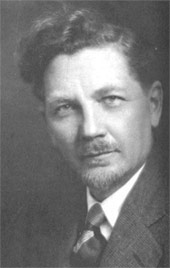Stephen P. Timoshenko
| Stephen Timoshenko | |
|---|---|
 |
|
| Born | Тимошенко Степан Прокопович Stepan Prokopovych Timoshenko December 23, 1878 Shpotivka, Ukraine |
| Died | May 29, 1972 (aged 93) Wuppertal, Germany |
| Fields | Engineering Mechanics |
| Institutions | Kyiv Polytechnic Institute, University of Michigan, Stanford University |
| Alma mater | St.Petersburg Ways of Communication Institute |
| Doctoral students | |
| Known for | Timoshenko beam theory |
| Notable awards |
Louis E. Levy Medal (1944) Timoshenko Medal (1957) Elliott Cresson Medal (1958) Fellow of the Royal Society |
Stepan Prokopovych Tymoshenko (Ukrainian: Степан Прокопович Тимошенко, Russian: Степан Прокофьевич Тимошенко; IPA: [sʲtʲɪˈpan prɐˈkofʲɪ̯ɪvʲɪt͡ɕ tʲɪmɐˈʂɛnkə]) (December 23, 1878 – May 29, 1972), was a Ukrainian and, later, an Americanengineer. He is considered to be the father of modern engineering mechanics. A founding member of the Ukrainian Academy of Sciences, Timoshenko wrote seminal works in the areas of engineering mechanics, elasticity and strength of materials, many of which are still widely used today. Having started his scientific career in the Russian Empire, Timoshenko emigrated to Yugoslavia during the Russian Civil War and then to the United States.
Timoshenko was born in the village of Shpotivka in the Chernigov Governorate of Ukraine. He studied at a "realnaya" school (Russian: ) in Romny, Poltava Governorate (now in Sumy Oblast) from 1889 to 1896. In Romny his schoolmate and friend was future famous semiconductor physicist Abram Ioffe. Timoshenko continued his education towards a university degree at the St Petersburg Institute of engineers Ways of Communication. After graduating in 1901, he stayed on teaching in this same institution from 1901 to 1903 and then worked at the Saint Petersburg Polytechnical Institute under Viktor Kyrpychov 1903–1906. In 1905 he was sent for one year to the University of Göttingen where he worked under Ludwig Prandtl.
...
Wikipedia
